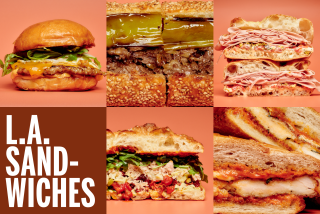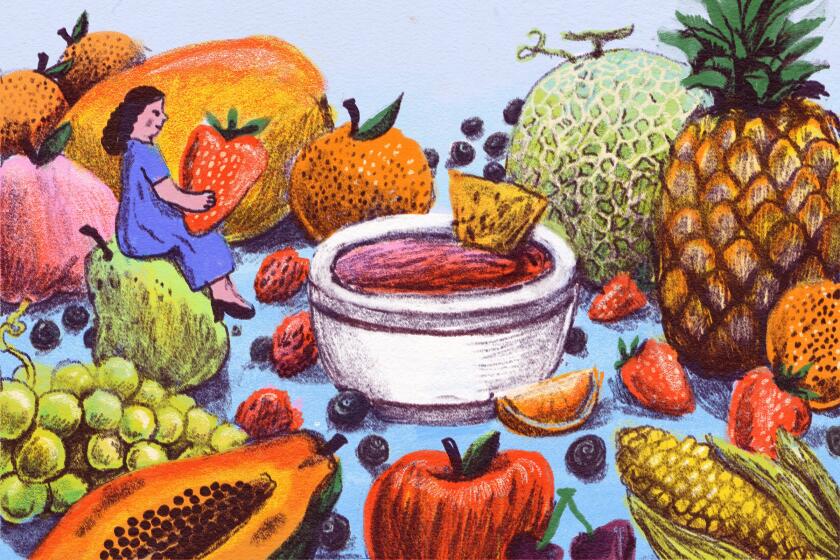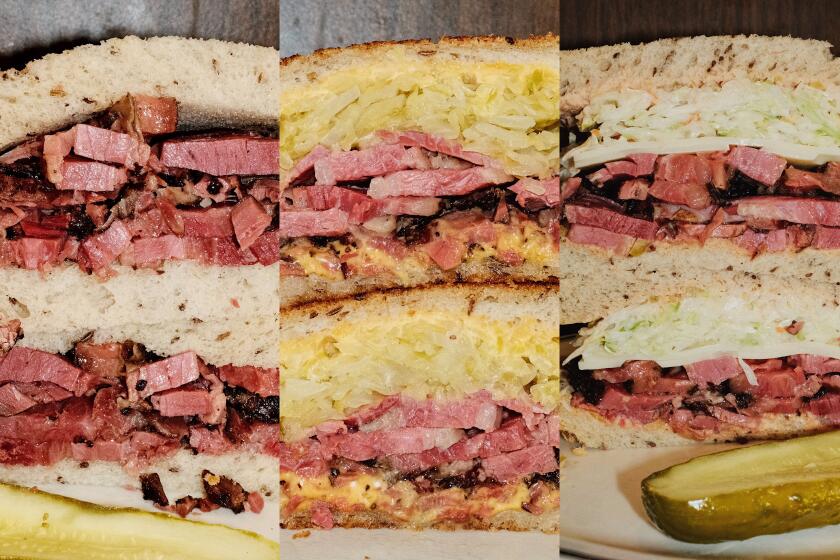say Cheese : Specialty cheeses prove how much fun they are to use in a spinach pizza made with feta and Parmesan from Michael’s Pizza in Aptos, Calif., in photograph below. At right, an appetizer of Brie layered with sage leaves was inspired by chef Ken Frank of La Toque.
Ever hear of stracchino? Gorgonzola? Cotija? How about manchego or mascarpone ?
Need a clue?
Say “cheese.”
Then say “specialty cheese,” or, if you prefer, “gourmet” or “boutique” cheese, the names used to describe a new category of cheeses that is growing in popularity in an affluent consumer market, even though many of the cheeses are as old as man.
And while you’re at it, call them “fun” cheeses if you want, because they are the cheeses that make modern cooking a joy and eating them an Epicurean delight.
Specialty cheeses are fast becoming today’s popular cheeses. They haven’t yet replaced the “big three”-- Cheddar, Jack and mozzarella (in that order)--which command 75% of the cheese market, according to Elton Brooks of the Milk Stabilization Branch of the California Department of Food and Agriculture in Sacramento.
According to John Ressi of Everfresh Foods Inc. in Ontario, whose company is one of the largest importers of specialty cheeses, the big specialty cheese sellers, such as French Brie, Norwegian Jarlsberg and Danish Havarti, are on a continual climb, but even the lesser-known so-called gourmet cheeses have doubled in growth sales in the last five years, say the experts. “Brie is considered a commodity now. We used to sell 200 wheels of Brie a month, now it’s in the thousands. Others, like the fresh cheeses coming into market lately, have easily doubled as well,” Ressi said.
Most gourmet food stores, such as the Cheese Shop in Beverly Hills, have seen a 100% rise in sales of specialty cheeses. “Specialty cheeses are part of the California cuisine picture now,” said owner Norbert Wabnig. Goat cheese sales, Wabnig said, have skyrocketed, and many blue cheeses are being used in cooking. “People are trying mascarpone with basil and pine nuts and Gorgonzola with white truffles when in season. Bufala mozzarella is also a big seller now. People never had real Parmesan until they tried Reggiano,” Wabnig said.
Rene Hanks, the cheese manager at Bristol Farms in Pasadena, reports the most popular cheeses are Brie and Camembert, with Parmesan Reggiano “right up there.”
“Today we’re doing a lot more consumer education of cheese at the cheese counter because people are now more interested in what they are eating than ever,” she said.
What has caused the booming business in specialty cheeses?
“Travel, restaurants, health concerns and a better food distribution system,” answered Larry Osborn, purchasing agent at Peacock Cheese Co. in Vernon, a large distributor of specialty cheeses.
“Only five years ago, most Americans used only a few cheeses--yellow, white and cheese food. Now people are conscious of what they are eating and learning more about it. With a far better distribution system available today, more and more perishable fresh cheeses have entered the market to compete for the consumer dollar,” he said.
Transfer of the small business cheese trade to the supermarkets has also helped expose specialty cheeses to a wider consumer market. “We estimate that there has been a 70% increase in supermarkets going in for expanded cheese tables in the last 10 years. That means there has also been a gradual extinction of the small mom-and-pop cheese shop business,” Ressi said.
The up-and-coming cheeses are now both imported and domestically produced Italian bufala mozzarella (both dried and fresh) and French and American chevre (fresh goat cheeses) which come in a variety of flavors, shapes and sizes and are considered healthful because of their low-fat content. Fresh cheeses contain less fat and are less caloric (about 90 calories per ounce) than aged cheese, which contains an average of 150 to 200 calories per ounce.
In fact, many formerly imported cheeses are now manufacturered in the United States due to Food & Drug Administration restrictions on some imported cheeses. California-made mozzarella is gaining in popularity. It’s still expensive, but not as expensive as imported fresh cheeses from Italy or France, and far fresher. Even creme fraiche , manufactured locally, is gaining in popularity. French double and triple cream cheeses also are growing rapidly with St. Andre, manufacturered in small, tall rounds, among the most popular.
Fontina and Gorgonzola, once affected by an FDA ban some years back, now are being co-produced in the United States, thus enhancing both quality and cost. “We’re getting the benefit of European quality manufacturing methods done domestically. The cheeses may not always be duplicated exactly, or be as good as the European original because of milk, climate and bacteria differences, but they are definitely improving the cheese picture for Americans,” Osborn said.
Although slower than most specialty cheeses in growth rate, gaining in the consumer market are the British cheeses, such as Stilton, sage Derby (similar to Cheddar with sage flavoring), Cotswold (similar to Cheddar with onion and chives) and Huntsman (double Gloucester with some Stilton added), plus the typically popular British cheeses, such as Cheshire and Caerphilly, most of which are used strictly as dessert cheeses.
Perishability a Factor
The high perishability factor of Stilton, for instance, at a cost as high as $9 to $10 per pound, makes such cheeses almost prohibitive, while Brie and Jarlsberg are in the $5 to $6 per pound range, according to Ressi. English Farmhouse Cheddar, a country cheese cut from 60-pound cylinder wheels, is the most popular and the most expensive of the Cheddars, according to Wabnig. “People are willing to pay the price as they become more in tune to the differences and quality of cheeses,” he said.
While Mexican cheeses are largest in the category of growing specialty cheeses, only about 15% of Mexican cheese production is finding its way to Anglo consumers, explained Frank Gutierrez, vice president of Cacique Inc. in the City of Industry.
Most of the Mexican cheeses are purchased chiefly by Mexicans, who value the fresh, country style cheeses, such as queso fresco (panela, queso adovera and queso fresco , the major fresh types). Fresh cheeses, in fact, represent a growth of about 55% to 60% in the last five years. This can be attributed in part to the increase in immigrant populations from Central America who make use of the fresh cheeses, as well as a growing affluent Mexican population who favor country-type fresh cheeses and are willing to pay the price.
However, fresh Mexican cheeses such as as crema Mexicana, the softest and freshest of all Mexican cheeses and similar in texture to creme fraiche, except it is more creamy and sweet; cotija, a semi-hard grating cheese; and manchego, a melting cheese of Spanish origin, ideal in fondue (fondito), melted cheese sandwiches and quesadilla, are making great headway in the Anglo market, according to Gutierrez. Even queso maduros, the aged Mexican hard cheeses, such as queso asdero, used in sandwiches, are filtering into the Anglo market.
“Americans are realizing that authentic Mexican cooking has to be done with Mexican-type cheese and not with Jack or Cheddar. As consumers become more traveled and educated about cheese, popularity of Mexican cheeses will continue to grow in the Anglo market,” Gutierrez said.
Canadian white Cheddar, considered the finest white Cheddar in the world, is another specialty cheese growing in popularity among American cheese shoppers. Others, such as the semi-soft, pungent Oka, have not had the same commercial success so far.
‘Always Popular’
Feta, a white fresh salty cheese, has become widely popularized. “Feta was always popular, but more so now. Real Bulgarian feta is obviously making more of an impact now than before. In the past we had Danish feta and California feta and no others,” Wabnig said.
Although Bulgarian feta is considered the prime feta today, taste often dictates the type of feta desired. Bulgarian is more creamy and less crumbly than Greek. French and Danish are firm-type fetas that slice neatly. However, some Greek fetas, such as those made in Ioannina (Epirus) and found in some restaurants such as Grandia Palace in Los Angeles, are ideal in Greek-style cooking and as meze (appetizers), and well worth a try.
Italian fresh cheeses are moving into the market more slowly because of their high perishability. The highly perishable Italian stracchino (soft-ripened) and caprini (a creamy Italian goat cheese) are hard to find, but even they have made relative headway into the American cheese market. “So far they are too perishable for most distributors to handle properly, but can be found now and then,” Osborn said.
Finnish cheeses, such as Lapi, the Jack-type cheese, are also making inroads.
Ressi credits some of the growth in specialty cheese consumption to the expanding wine industry. “The wine industry has definitely helped put specialty cheeses on the map, because they are eating cheeses primarily and (cheese is) a natural with wine,” Ressi said.
But restaurant chefs helped too.
Availability has made it possible for more and more innovative California-style restaurant chefs to incorporate the varied international specialty cheeses into their recipes.
Smoked Cheeses Featured
At Authentic Cafe in Los Angeles, chef-owner Roger Hayot uses smoked cheeses such as Italian smoked mozzarella, Dutch Gouda, Mexican manchego and French Brie in sandwiches, chile relleno, tostadas, salads and chicken dishes. Pizza is made with goat cheeses, and Gorgonzola is teamed with unusual fruit, such as kumquats, in salads.
At Stanley’s in the San Fernando Valley, Italian Fontina is teamed with mozzarella in pizzas. At Trumps in Beverly Hills, goat cheese is used with sauteed apples to serve with potato pancakes. A gratin of potatoes is made with both Swiss Gruyere and Italian Pecorino. And Roquefort is melted into a demi-glaze sauce for grilled lamb chops.
At La Pazzia, one of the newest crop of chic trattorias in Los Angeles, the chefs under the direction of proprietor Mauro Vincente prepare foccacia filled with cubes of stracchino, the highly perishable and hard-to-find soft, fresh cheese from Florence. Taleggio from Piedmonte served spread on bread is ideally accompanied with a good bottle of Barbaresco.
At La Toque in Beverly Hills, chef Ken Frank slices a 6-inch loaf of soft-ripened Brillat-Savarin with guitar strings to fill with copious amounts of truffles, then ripened for three days to serve sliced into wedges for appetizers with drinks. “The cheese, a Harry & David quarter-sliced pear to go with sliced toasted brioche, and you are in heaven,” Frank said.
Joe Venezia, the chef at Mason’s restaurant in West Los Angeles, mixes ricotta with mashed potatoes to make ravioli dough. White Canadian-style Cheddar made in Vermont is served in tortilla soup with quesadillas. Bufala mozzarella is marinated in a mixture of basil and olive oil to serve with tomatoes and arugula. Triple-cream Brie is served on a fruit tray with Champagne grapes and crouton triangles.
Here are some recipes from the chefs to inspire cooking with specialty cheeses. See the glossary of specialty cheeses on Page 40.
TRUMP’S EGGPLANT CAVIAR WRAPPED IN RADICCHIO
1 (1 1/4-pound) eggplant, halved
2 tablespoons olive oil
2 cloves garlic, minced
Salt, pepper
8 ounces goat cheese or fresh bufala mozzarella, diced or chopped
16 radicchio leaves
Pierce eggplant in several places and cook in microwave oven on HIGH (100% power) about 6 to 8 minutes or until tender. Cool, then scoop out flesh, discarding seedy portion. Mash flesh with fork or puree in food processor.
Whisk olive oil into eggplant. Add garlic. Season to taste with salt and pepper. Mix in goat cheese.
Spread 1 tablespoon eggplant mixture over each radicchio leaf and roll, jellyroll fashion. Continue until all filling and leaves are used. Wrap in plastic wrap and chill several hours. Serve as rolls or cut rolls into 1/2-inch slices and serve as hors d’oeuvre. Makes 16 rolls.
MASON’S POTATO QUESADILLA
1 medium potato, peeled and finely diced or mashed
1 Maui or Spanish onion, chopped
1 small leek, thinly sliced
Butter
3 asparagus spears, diced
1 Anaheim chile, roasted, peeled and chopped
Salt, pepper
4 (10-inch) flour tortillas
1/2 avocado, sliced
Chopped cilantro
4 ounces Canadian white Cheddar cheese, grated or finely diced
Salsa
Saute potato, onion and leek in 2 tablespoons butter until potato is tender, about 7 minutes. Add asparagus and chile and saute 3 minutes. Season to taste with salt and pepper.
Spoon 1/2 potato mixture over each of 2 flour tortillas. Top with avocado slices and sprinkle with cilantro and cheese. Top with remaining flour tortillas, pressing down slightly. Brush with 2 teaspoons melted butter.
Bake at 400 degrees until cheese begins to melt and tortillas are crisp. Broil briefly until lightly browned. Cut into wedges and arrange around edge of platter. Place bowl of Salsa in center. Garnish with cilantro. Makes 2 tortillas.
Salsa
1 tomato, chopped
1/4 jalapeno chile with seeds, minced
1/4 small red onion, diced
1 tablespoon chopped cilantro
Salt, pepper
Mix together tomato, minced jalapeno, onion, cilantro and salt and pepper to taste. Makes about 1 1/4 cups.
LA TOQUE’S TRUFFLED BRILLAT-SAVARIN LOAF
1 (8-inch) Brillat-Savarin wheel
1 or 2 fresh truffles, shaved
Sliced pears
Toasted brioche slices
Slice cheese wheel horizontally into 2 equal layers, using cheese wire or heavy thread. Sprinkle each layer with truffle. Stack and wrap airtight in plastic wrap. Store in refrigerator about 3 days to flavor cheese.
When ready to serve, slice into 16 wedges and serve on platter with sliced pears and toasted brioche slices. Makes 16 servings.
Variation: Substitute 8-inch wheel Brie for Brillat-Savarin and sliced stuffed olives or fried sage or spinach leaves for truffles.
Fried Sage Leaves
Bunch fresh sage leaves or young spinach leaves
Flour
Oil
Clean and pat dry sage leaves. Dust lightly with flour. Heat 1-inch oil in skillet. Drop sage leaves into hot oil and cook few seconds until crisp. Remove immediately with slotted spoon. Drain on paper towels.
KUMQUAT-GORGONZOLA SALAD
2 cups assorted broken baby lettuce leaves
1 Italian plum tomato, quartered
1/2 small red onion, thinly sliced
4 ounces smoked chicken, thinly sliced
2 mushrooms, sliced
1 to 2 ounces gorgonzola cheese, crumbled
6 or 7 kumquats, sliced thinly or in wedges
Balsamic Vinaigrette
Place lettuces on serving plate. Arrange tomato wedges on each corner of plate. Place onion slices around center of plate. Arrange chicken slices around perimeter of salad. Place mushroom slices between tomatoes. Sprinkle gorgonzola over top. Garnish plate with kumquats. Dress with Balsamic Vinaigrette. Makes 1 serving.
Balsamic Vinaigrette
2 tablespoons balsamic vinegar
2 tablespoons olive oil
Salt, pepper
Combine vinegar, oil and salt and pepper to taste. Makes 1/4 cup.
FOCACCIA ALLA PAZZIA
1 (10-ounce) refrigerated package pizza dough
4 ounces (about) stracchino or Gruyere cheese, shredded
Olive oil
Divide pizza dough into 8 portions. Roll each portion into 4-inch circle. Place about 1 ounce stracchino in center of 4 circles. Top with remaining circles and pinch edges to seal.
Place on baking sheet and brush lightly with olive oil. Bake at 400 degrees 15 to 20 minutes or until bread is done. Do not overbake. Makes 4 foccacia.
JOE VENEZIA’S RICOTTA RAVIOLI
1/4 pound ricotta
1 medium potato, cooked and mashed
1/2 cup cooked or thawed frozen spinach, chopped
Dash ground nutmeg
Salt, pepper
1 egg yolk
Flour
Ravioli Dough
1 egg white, lightly beaten
1 cup butter
18 to 24 fresh sage leaves
Parmigiano Reggiano cheese, freshly grated
Combine ricotta and potato and mix well. Add spinach, nutmeg, salt and pepper to taste and egg yolk, mixing well.
On generously floured board and using floured rolling pin, roll out Ravioli Dough into 12-inch circle. Cut into about 7 (4-inch) rounds. Brush edges of dough with egg white mixed with 1 teaspoon water.
Place 1 teaspoon ricotta filling in center. Bring edges together in center and pinch together to make 3 or 4 corners. Drop into boiling salted water and cook until ravioli rise to surface. Drain.
Heat butter in skillet with sage and cook until golden brown. Pour over ravioli. Sprinkle with Parmigiano Reggiano cheese. Makes 6 servings.
Ravioli Dough
3 cups flour
1/2 cup plus 1 tablespoon ricotta
3 egg yolks
4 ounces whipping cream
1/3 to 1/2 cup water, about
Place flour in mound on clean board. Make well in center and add ricotta cheese, egg yolks and cream. Gradually incorporate cheese mixture into flour mixture, adding as much water as needed to make soft pliable dough. Knead only until soft and smooth. Do not overwork dough.
GRILLED FIGS STUFFED WITH TRIPLE CREAM
6 fresh figs
1 tablespoon butter, melted
6 ounces (about) ricotta, double or triple cream cheese or other soft cheese
Sesame seeds, toasted
Crackers
Edible flowers
Split figs, not cutting entirely through. Brush with melted butter. Grill until roasted on skin side. Fill center with heaping tablespoon cheese and close figs part way. Sprinkle with sesame seeds. Serve 1 to plate and garnish with crackers and edible flowers. Makes 6 appetizers.
Note: Package edible flowers may be purchased at gourmet food stores.
BETTY’S SPINACH AND CHEESE PIZZA
1 pound spinach
1 tablespoon virgin olive oil
1/4 cup half and half
1 egg, beaten
Pepper
8 ounces feta cheese, crumbled
1 recipe pizza dough
4 or 6 Fried Spinach Leaves
Parmigiano Reggiano cheese, freshly grated
Clean and chop spinach. Heat olive oil and add spinach. Cook few seconds, tossing just enough to coat. Set aside.
Beat together half and half, egg and pepper to taste. Add to spinach mixture with feta cheese. Roll pizza dough about 12 inches in diameter, bringing up edges to make tall rim.
Spread spinach-cheese mixture over dough. Garnish with Fried Spinach Leaves. Sprinkle with Parmigiano Reggiano cheese. Loosely cover top of filling with foil. Bake at 400 degrees until pizza crust is golden and filling is firm, about 25 minutes. Cut into wedges to serve. Makes 6 servings.
Fried Spinach Leaves
1 bunch fresh spinach
Flour
Olive Oil
Select uniform size leaves, large or small. Dust lightly with flour. Heat 1 inch olive oil in skillet. Drop spinach leaves in hot oil and fry until spinach leaves are crisp. Remove with slotted spoon and drain on paper towels.
Food styling by Minnie Bernardino and Donna Deane
More to Read
Eat your way across L.A.
Get our weekly Tasting Notes newsletter for reviews, news and more.
You may occasionally receive promotional content from the Los Angeles Times.










